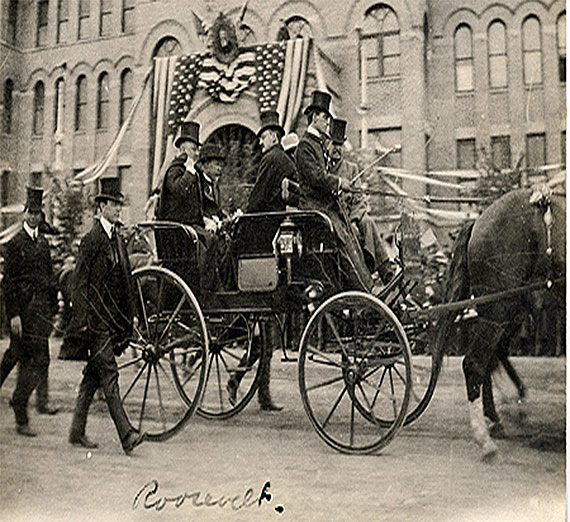Road to GU's 125th Anniversary: A Look Back at 1902-03

1902-03
By Mary Jantsch
Class of 2013
SPOKANE, Wash. — On May 26, 1903, President Theodore Roosevelt made an unplanned stop at Gonzaga while visiting Spokane. Roosevelt was the first president to travel to the Inland Northwest and Gonzaga College, like many others, applied for an opportunity to welcome the president.
Though it was thought to be unlikely President Roosevelt would stop at Gonzaga, Rev. Raphael Crimont, S.J., Gonzaga's president from 1901-1904, nevertheless made elaborate preparations to welcome him.
Rev. Wilfred P. Schoenberg, S.J., in his book "Gonzaga University: Seventy-five Years, 1887-1962" paints a scene of flags and bunting stretching all the way across College Hall, then known as the Administration Building. A large painting of the President Roosevelt was installed above the entrance of the College. Flowers were gathered, and students were invited to line the street. Rev. Henry McCulloch, S.J., composed a Latin poem for the occasion.
Father Crimont wasn't the only person eager for Roosevelt's visit. When May 26 finally dawned, an estimated 20,000 visitors poured into the city; all business closed for the day and schools were canceled. More than 6,000 children, dressed in white suits and dresses, gathered in Coeur d'Alene Park. Roosevelt would arrive at 2:35 p.m. via the Oregon Railroad and Navigation Company train.
The presidential train was on its way from Coeur d'Alene to Spokane. It was then, according to an interview with Rev. Michael O'Malley, S.J., noted in Schoenberg's book, that someone casually remarked within earshot of Roosevelt that people in Spokane were intolerant toward Catholics. Roosevelt asked if there were any Catholic colleges in Spokane and was told of Gonzaga. His schedule rerouted, President Roosevelt's Studebaker made its first stop at Gonzaga College where Fr. Crimont, Gonzaga faculty, staff and students were eagerly waiting.
Roosevelt rose in his carriage and reportedly said: "I thank you, Father, the faculty and the students of Gonzaga College. I appreciate the gift you have given and I appreciate still more the words you have uttered and the sincerity of your devotion."
After leaving the college, Roosevelt went back to his prepared schedule but was forced to leave out the children's speech and the cornerstone ceremony. He left the city at precisely the time arranged.
While the flags and bunting were stored away and his portrait taken down, the occasion lasted as an inspiring moment for Gonzaga and its students.
"The President of the United States by his action had shown them, and the whole world also, how to be tolerant toward those who have different religious beliefs from one's own," Schoenberg explained. "They never forgot the lesson."
Other notable events that took place during the 1902-1903 school year included:
- The beginning of a $250,000 addition of 255 feet onto the east side the Administration Building; finished in March 1904.
- A noticeable improvement for all departments of the Gonzaga Corps; attention was called to the neatness of uniforms and the frequency and accuracy of drills.
- Gonzaga claimed the title of largest Catholic college in the Pacific Northwest and one of the larger Jesuit colleges in the United States.
